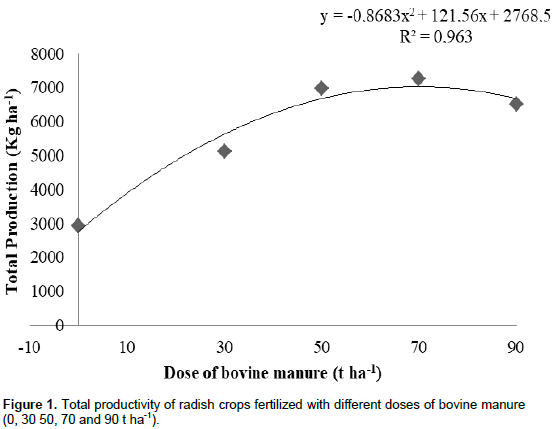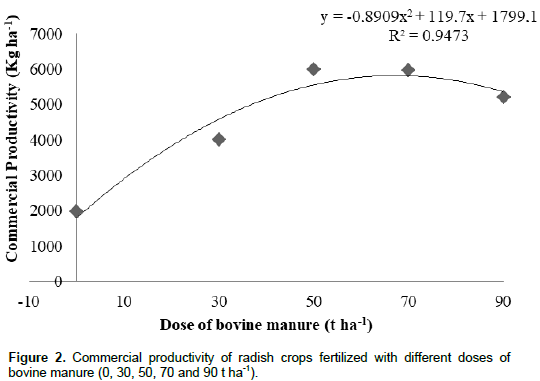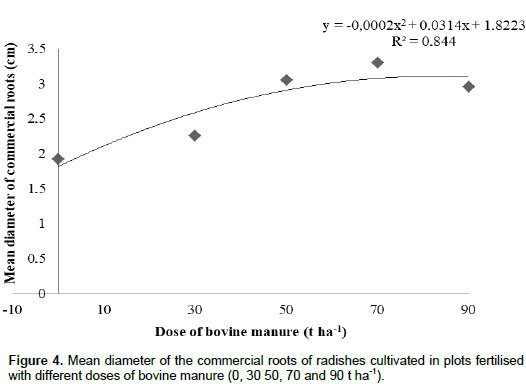ABSTRACT
The application of organic matter to the soil has considerable benefits for agricultural land, including an improvement in the physical structure and fertility of the soil, which can often be extended from one crop to another. Animal manure is one of the most widely-used types of organic fertilizer, due in part to its availability. The present study investigated the productivity of radish exposed to different doses of bovine manure. The research was conducted at the experimental area of the Nova Xavantina campus of Mato Grosso State University, in central Brazil, using the Apolo radish cultivar. The experimental design was based on the random distribution of plots, with five repetitions. Five treatments were applied, representing different doses of bovine manure: T1 = 0 t ha-1, T2 = 30 t ha-1, T3 = 50 t ha-1, T4 = 70 t ha-1, and T5 = 90 t ha-1. The 50 t ha-1 dosage performed best in terms of the productivity and quality of the Apolo radish cultivar under the conditions of the present experiment.
Key words: Raphanus sativus L., organic fertilizer, plant nutrition.
The consumption of fresh vegetables has increased worldwide, not only through population growth, but also due to the greater awareness of the importance of a healthy diet. Consumers are also becoming increasingly demanding, in terms of the quality of the produce, and its year-round availability (Bonela et al., 2017). The Brazilian Center for Advanced Studies in Applied Economics (Cepea, 2017) reports that the total output of fresh vegetables in Brazil is 63 million tons, produced by a total area of 837,000 ha of farmland. An enormous variety of crops are cultivated, and São Paulo is the state that produces most vegetables. The radish (Raphanus sativus L.) is an edible plant of the family Brassicaceae, with a globular root that has a bright pink external layer and a white pulp. The root is the part consumed, that is, it is the commercial product. One of the unique features of this plant is its short cycle, of approximately 30 days, which permits rapid gains of working capital (Rodrigues et al., 2013; Matos et al., 2015). The relative advantages and disadvantages of the application of mineral and organic fertilizers for the cultivation of different crops have been amply discussed. On the one hand, mineral fertilizers make nutrients available to the plant rapidly, especially where the soil has a strict C/N relationship, although they have little effect on the physical structure of the soil. On the other hand, while organic fertilizers may not have sufficient concentrations of nutrients to guarantee the requirements of the crop, they do impact the physical, chemical, and biological properties of the soil (Olivera et al., 2015). The rapid mineralization of organic matter under conditions of high temperature and ample sunlight is one of the principal limitations for the production of vegetables, given the reduced availability of nutrients, in particular nitrogen, in the production system (Silva et al., 2017).
These authors report that one of the options available to overcome this nutrition deficiency in the plants is the application of organic fertilizers, including bovine manure, which is the most widely-used, given its availability, and potential for the full or partial fulfilment of the nutritional requirements of some crops. Matos et al. (2015) concluded that one of the principal advantages of the productive systems based on organic fertilization, is the capacity of this process to increase the stocks of C and N in the soil, which is important for its conservation and fertility. In addition to providing nutrients such as N, P, K, S, and micronutrients, the incorporation of organic matter into the soil reduces its apparent density (Costa et al., 2006), and forms aggregates, improving aeration and the water storage capacity. Organic fertilizers also complex and solubilize some heavy metals, buffering the soil and maintaining the pH during abrupt changes in the environment. Other benefits include a reduction of the toxic effects of aluminum and an increase in microbial activity, which results in more favourable conditions for the establishment of the root system (Silva et al., 2006). The benefits of applying organic matter to plantations have been widely reported (Silva Junior et al., 2016), and plants fertilized with organic compounds develop better and have more balanced nutrition that those fertilized using only mineral compounds. The present study investigated the productivity of radish fertilized experimentally with different doses of bovine manure in Central Brazil.
The experiment was set up in the experimental area of the Nova Xavantina campus of Mato Grosso State University, in Central Brazil. This area is located within the Mário Viana Park, a reserve known as Bacaba Park (15°42’55” S, 52°14’54” W) at an altitude of 301 m above sea level. The region’s climate is of the Aw type in the Köppen classification system, with mean annual precipitation of 1600 mm (Marimon et al., 2010), and two, well-defined seasons, a dry season from May to September, and a rainy season, from October to April. The soil of the experimental area is a dystrophic red latosol with a sandy texture and 0 to 15% clay (Embrapa, 2013). The soil was sampled at 10 points, in the 0 to 20 cm layer (Table 1). The experimental design was based on random blocks, with five repetitions. The treatments (T1 to 5) were based on the following doses of bovine manure: 0 t ha-1 (T1), 30 t ha-1 (T2), 50 t ha-1 (T3), 70 t ha-1 (T4), and 90 t ha-1 (T5), each with five repetitions for a total of 25 plots. The plots (experimentall units) measured 1.0 m × 1.0 m, with five row of plants in each plot, at intervals of 0.30 m. The central 1 m2 of each plot was sampled, with the outer portion not being included, to avoid potential edge effects. The soil was prepared manually using a hoe to turn over the hardest, uppermost layers of the soil, and then to prepare the planting rows, raised to a height of approximately 30 cm. The analysis of the soil (Table 1) indicated that no lime was necessary. The manure was incorporated into the soil three days before sowing. The Apolo cultivar was selected for this experiment, due to its good quality roots, robust plants, and vigorous and uniform foliage.
The seeds were sown directly into the rows, with three seeds per 2 cm hole. At 7 Days After Emergence (DAE) of the seedlings, the plants were thinned, leaving a distance of 0.10 m between seedlings in the same row. Weeds were removed manually whenever necessary. Nitrogen was applied as cover in the form of ureia (100 kg ha-1), in all treatments, with 50% being applied at 10 DAE, and 50% at 20 DAE. The plots were irrigated daily by sprinkling, to a depth of approximately 8 mm, to guarantee the development of the crop. The plants were harvested 35 days after sowing, and the following parameters were determined for each treatment:
1. Total production (t ha-1): Based on the weight of 27 plants collected from the sampling area, obtained using a digital balance;
2. Commercial productivity (t ha-1): A total of 27 plants were collected from the sampling area of each experimental unit, and the split roots were discarded. The remaining roots were weighed immediately after harvesting to determine the commercial productivity. Roots were considered to be commercially valid when they had a diameter of at least 3 cm, and had no splits;
3. Diameter of commercial roots (cm): The diameter of the roots of 27 plants from each sample area (not including split roots) was measured at the middle of the root with a calliper (in cm);
4. Percentage of split roots (%): The percentage of split roots was determined by subtracting the commercial productivity from the total production of radish roots.
The data were analyzed and the pattern of the effect of different doses on the production parameters was evaluated using a regression, run in the Assistat 7.7 program (Silva and Azevedo, 2016).
The maximum total productivity (7253.4 kg ha-1) was obtained by applying 70 t ha-1 of manure (Figure 1). The control plots (T1: 0 t ha-1) returned a productivity of 2927.2 kg ha-1, 59.64% less than the maximum recorded. Cortez (2009) obtained higher productivity (9950 kg ha-1) using 75 t ha-1 of manure and 180 kg ha-1 of N. In this study, increasing doses of manure and N contributed to an increase in the height of the plant, the fresh weight of the root, and the commercial productivity of the radish. The concentration of organic matter in the soil (12.3 g dm-3) was relatively low in this study, however, in comparison with the present study (Table 1). This may have made nitrogen more available to the radish plants (Vitti et al., 2007), which may account for the higher productivity recorded. In contrast with the results of the present study, Cardoso et al. (2001) recorded relatively low levels of productivity (3.60, 4.71 and 5.05 t ha-1) at doses 100, 200, and 300 kg ha-1 of N, respectively. In the present study, treatment (30 t ha-1 of manure with 100 kg ha-1 N) resulted in a total production similar to the maximum value recorded in this previous study. Raij et al. (1997) concluded that doses of N of above 200 kg ha-1 may lead to superfluous consumption, with the plant continuing to absorb nitrogen, even after reaching maximum growth and productivity, resulting only in an increase in nitrogen concentrations in the foliage, without affecting the other parts of the plant. Taiz and Zeiger (2012) confirm this conclusion, showing that the concentration of nitrogen increases in the plant tissue, without contributing to any increase in growth or productivity, given that the plant has reached its prime.


Commercial productivity refers to the portion of the radish crop with no split roots. The maximum commercial productivity recorded in the present study (5962.0 kg ha-1) was obtained at a dosage of 70 t ha-1 of bovine manure (Figure 2), which represents an increase of 66.97% in comparison with the minimum commercial productivity recorded here (1969.2 kg ha-1), for treatment 1 (0 t of manure ha-1). A number of studies of the use of organic fertilizer have confirmed productivity equal to or higher than that obtained using industrial nitrogenated fertilizers (Viana et al., 2004), confirming the results of the present experiment. Bonela et al. (2017) evaluated the productivity and quality of radish roots following the planting of lettuce with organic fertilization. In this case, the dose of 60 t of bovine manure produced the best results in terms of the quality of the roots. In the present study, treatment 4 (70 t ha-1) resulted in the highest percentage of split roots (13.73%), and the smallest value (9.72%), recorded for treatment 3, that is, 50 t ha-1 (Figure 3). The application of organic fertilizer may have had some effect on the appearance of splits in the radish roots. Oliveira et al. (2001) found evidence that the use of organic fertilizers resulted in deformations of the roots of carrot, as also observed by Costa et al. (2006) in radish. These authors observed a high frequency of splits in the roots of radishes cultivated using earthworm humus and bovine manure. Kaseker et al. (2014) also concluded that the application of organic fertilizers (bovine manure) may contribute to an increase in the malformation of carrot roots. Bregonci et al. (2008) found that the oscillations in the water content and temperature of the soil, in particular its surface layer, resulting from high temperatures and the lack of mulch, which favors rapid evapotranspiration, contribute directly to the splitting of tuberous roots.


Marques et al. (2005) confirmed that irregular oscillations in the irrigation regime contributed to splits in radish roots. Raij et al. (1997) found that excessive fertilization with nitrogen may also contribute to root splitting in the radish. Cardoso et al. (2001) obtained similar results, showing that while an increase in the dosage of nitrogen resulted in an increase in productivity, it also provoked an increase in the proportion of split roots, probably due to their increased size. Zambon et al. (2001) studied 16 radish cultivars on the high plains of the Brazilian state of Paraná, and recorded a positive correlation between the production of foliage and the concentrations of boron. Cecílio Filho (2017) not only confirmed that radish is sensitive to boron levels, but also that the scarcity of this nutrient may lead to the necrosis of the root tuber. Boron has a number of functions in the plant, but it was present at extremely low concentrations (0.25 cmolcdm-3) in the soil at the present study site, which may have contributed to the splits observed in the radish roots. Given these considerations, it would be important to investigate specifically the influence of this nutrient on the cultivation of radish. Treatment 3 (50 t bovine manure ha-1) returned the largest mean diameter of commercial roots (3.06 cm), while the smallest diameter was recorded in treatment 1, that is, in the absence of organic fertilizer (Figure 4). These results are consistent with the findings of Grangeiro et al. (2008), who showed that consumers preferred radishes with a root diameter of greater than 3 cm, and no splits. The diameter and weight of the tubercles, in addition to the production of split roots are the most important criteria for the evaluation of the optimum dosage of manure to be applied as fertilizer, given that these attributes are linked directly to the quality of the product, and its commercial value. Evaluating the productivity of radish in relation to the nitrogen dosage, Silva (2015) found that the root increased significantly in size with increasing doses of N in the experimental treatments.



The application of 50 t ha-1 of bovine manure was shown to be the optimal dosage to guarantee the quality and performance of the cultivation of radish of the Apolo cultivar under the experimental conditions applied in the present study.
The authors have not declared any conflict of interests.
REFERENCES
|
Bonela GD, Santos WP, Sobrinho EA, Gomes EJ (2017). Produtividade e qualidade de raízes de rabanete cultivadas sob diferentes fontes residuais de matéria orgânica. Rev. Bras. Agropecu. Susten. 7(2):66-74.
Crossref
|
|
|
|
Bregonci IS, Almeida GD, Brum VJ, Reis EF. Desenvolvimento do sistema radicular do rabanete em condição de estresse hídrico. Sci. Agric. 26(1):36-38.
|
|
|
|
|
Cardoso A, Hiraki H (2001). Avaliação de doses e épocas de aplicação de nitrato de cálcio em cobertura na cultura do rabanete. Hortic. Bras. 19(3):328-331.
Crossref
|
|
|
|
|
Cecílio Filho AB, Dutra AF, Silva GS (2017). Phosphate and potassium fertilization for radish grown in a latosol with a high content of these nutrientes. Rev. Caatin. 30(2):412-419.
Crossref
|
|
|
|
|
Cepea (2017) Perspectivas hortaliças.
View
|
|
|
|
|
Cortez JWM (2009). Esterco de bovino e nitrogênio na cultura do rabanete.
View
|
|
|
|
|
Costa CC, Oliveira CD, Silva CJ, Timossi PC, Leite IC (2006). Crescimento, produtividade e qualidade de raízes de rabanete cultivadas sob diferentes fontes e doses de adubos orgânicos. Hortic. Bras. 24:118-122.
Crossref
|
|
|
|
|
Embrapa (2013). Sistema Brasileiro de Classificação de Solos.
View
|
|
|
|
|
Kaseker JF, Bastos MC, Consalter R, Mógor AF (2014). Alteração do crescimento e dos teores de nutrientes com utilização de fertilizante organomineral em cenoura. Rev. Ceres 61(6):964-969
Crossref
|
|
|
|
|
Grangeiro LC, Negreiros MZ, Santos AP, Costa LM, Silva AR, Lucena RR (2008). Crescimento e produtividade de coentro e rabanete em função da época de estabelecimento do consórcio. Ciênc. Agrotecu. 32(1):55-60.
Crossref
|
|
|
|
|
Matos RM, Silva PF, Lima SC (2015). Partição de assimilados em plantas de rabanete em função da qualidade da água de irrigação. J. Agron. Sci. 4(1):151-164.
|
|
|
|
|
Marimon BS, Felfili JM, Lima ES, Duarte WM, Marimon Junior BH (2010). Environmental determinants for natural regenertionofgalleryforestatthe Cerrado Amazoniaboundaries in Brazil. Acta Amazônica, Manaus 40(1):107-118.
Crossref
|
|
|
|
|
Oliveira AP, Espínola FEJ, Araújo JS, Costa CC (2001). Produção de raízes de cenoura cultivadas com húmus de minhoca e adubo mineral. Hortic. Bras. 19(1):77-80.
Crossref
|
|
|
|
|
Oliveira AP, Gandine SM, Sabino SM (2015). Potencialidadedo uso de substrato organomineral no desenvolvimentode rabanete. Enc. Biosf. 11(22):173-178.
|
|
|
|
|
Raij BV, Cantarella H, Quaggio JA, Furlani AM (1997). Recomendações de adubação e calagem para o Estado de São Paulo.
View
|
|
|
|
|
Rodrigues JF, Reis JM, Reis MA (2013). Utilização de estercos em substituição a adubação mineral na cultura do rabanete. Rev. Trópic. 7(2):160-168.
|
|
|
|
|
Silva CJ, Costa CC, Duda C, Timossi PC, Leite IC (2006). Crescimento e produção de rabanete cultivado com diferentes doses de húmus de minhoca e esterco bovino. Rev. Ceres 53(305):25-30.
View
|
|
|
|
|
Silva AFA, Souza EGF, Barros Júnior AP (2017). Desempenho agronômico do rabanete adubado com calotropis procera (Ait.) R. Br. Em duas épocas de cultivo. Rev. Ciênc. Agron. 48(2):328-336.
|
|
|
|
|
Silva Junior GS, Silva RC, Silva CS, Pela A (2016). Produtividade e teor de nitrato de em rúcula em função da adubação com esterco de curral ou cama de aviário.
View
|
|
|
|
|
Vitti MR, Vidal MB, Morsell TB, Faria JL (2007). Resposta do rabanete a adubação orgânica em ambiente protegido. Rev. Bras. Agroecol. 2(1):1158-1161.
|
|
|
|
|
Taiz L, Zeiger E (2012). Fisiologia vegetal. São Paulo: Cengage learning, 774p.
|
|
|
|
|
Zambom FR, Lopes NP, Ferrarini JM, Crestani VJ (2001). Competição entre dezesseis cultivares de rabanete (Raphanus sativus L.), região de Piraquara - PR.
|
|